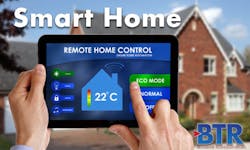Two recent research reports indicate healthy demand for smart home products, albeit with attendant integration challenges stemming from a patchwork of product sources and types. The market, which is increasingly tending toward retail sales, is expected to add $1.8 billion in new sales by the end of next year.
Retail Rules
According to Parks Associates, retail is now the most common purchase channel for smart home products. Among current smart home owners, 26% purchased their device from a retailer such as Home Depot, Walmart or Sears. Retail is followed by security dealers, online-only retailers, heating/cooling contractors, custom installers, broadband service providers, electricity providers, and other service contractors.
As more products are purchased standalone and then brought into a connected home, the risk of a fragmented consumer Internet of Things (IoT) experience increases, Parks says.
"There are increased opportunities across the consumer entertainment, technology, mobility, and connected home markets," said Dina Abdelrazik, Parks research analyst. "New use cases are emerging as access to consumer data is creating additional value, new methods of personalization, and the possibility of an enhanced user experience (UX). However, as consumers become more connected, their digital lives in many ways become more complicated, and solving this potentially fragmented consumer experience, addressing privacy concerns, and crossing traditionally separate boundaries will be the dominant challenges for companies in 2017 and 2018."
Other findings indicate:
- Global sales of wearables are expected to grow from 105 million units in 2016 to 241 million units in 2021, with sales of smart watches exceeding 129 million in 2021.
- Less than 13% of consumers have experienced VR.
- Standalone device sales have increased in every connected device segment between 2014 and 2016.
- Streaming media player sales in North America are expected to exceed 14 million units in 2020.
- The number of pay TV households in North America is expected to fall below 109 million by the end of 2021.
- Cord nevers make up a small but growing percentage of consumers at 5% of U.S. broadband households.
- Cord cutters and cord shavers account for a significant percentage of new OTT subscribers.
"Currently 19% of smart watch users want to use this device to lock/unlock their car, so we are starting to see consumer interest in connecting the smart devices in their home, and on their person, to the smart systems in their car," said Jennifer Kent, Parks' director, Research Quality & Product Development.
"OTT services like Netflix and Amazon and market developments like Whisker Labs' energy monitoring innovations, Vivint's AI-driven Sky Assistant, and Comcast Xfinity's imminent relaunch of EcoSaver are giving consumers more options, increased personalization, and enhanced value across the full spectrum of IoT experiences," Abdelrazik said. "Following early disruptions, many players are now rising to the challenge to create competitive solutions that better accommodate the needs of the connected consumer."
$1.8 Billion in New Sales
Related research from the NPD Group indicates that home automation products will add $1.8 billion of new consumer electronics sales through 2018. The research house forecasts 74% growth in the home automation category from 2016 to 2018, driven by sales of security and monitoring products, as well as growth in power and sensors.
"Awareness and interest are starting to build significantly for smart home products, with Alexa and Google Home catalyzing growth," said Stephen Baker, vice president, industry analyst for NPD. "Digital assistants will claim a major piece of the consumer market in 2018, and in doing so will drive adoption of compatible devices and solutions."
According to the report, emerging categories, such as virtual and augmented reality (VR/AR) and drones, will also be key contributors to new consumer electronics sales. Virtual reality is currently leading expansion of the VR/AR segment, with early use cases focused on making gaming, photos, and videos more immersive. NPD expects VR/AR sales in 2018 to be nearly four times higher than 2016 sales, while drone sales will double over the same time frame. Drone sales will be bolstered by the hobby category (priced above $200), for which there is a balance of strong demand and relatively high average sale prices.





